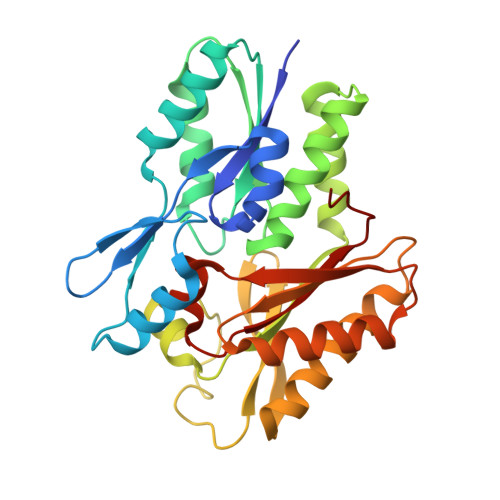Acyl-chain selectivity and physiological roles ofStaphylococcus aureusfatty acid-binding proteins.
Cuypers, M.G., Subramanian, C., Gullett, J.M., Frank, M.W., White, S.W., Rock, C.O.(2019) J Biological Chem 294: 38-49
- PubMed: 30429218
- DOI: https://doi.org/10.1074/jbc.RA118.006160
- Primary Citation of Related Structures:
5WOO, 6ALW, 6B9I - PubMed Abstract:
Fatty acid (FA) kinase produces acyl-phosphate for the synthesis of membrane phospholipids in Gram-positive bacterial pathogens. FA kinase consists of a kinase protein (FakA) that phosphorylates an FA substrate bound to a second module, an FA-binding protein (FakB). Staphylococcus aureus expresses two distinct, but related, FakBs with different FA selectivities. Here, we report the structures of FakB1 bound to four saturated FAs at 1.6-1.93 Å resolution. We observed that the different FA structures are accommodated within a slightly curved hydrophobic cavity whose length is governed by the conformation of an isoleucine side chain at the end of the tunnel. The hydrophobic tunnel in FakB1 prevents the binding of cis -unsaturated FAs, which are instead accommodated by the kinked tunnel within the FakB2 protein. The differences in the FakB interiors are not propagated to the proteins' surfaces, preserving the protein-protein interactions with their three common partners, FakA, PlsX, and PlsY. Using cellular thermal shift analyses, we found that FakB1 binds FA in vivo , whereas a significant proportion of FakB2 does not. Incorporation of exogenous FA into phospholipid in Δ fakB1 and Δ fakB2 S. aureus knockout strains revealed that FakB1 does not efficiently activate unsaturated FAs. FakB2 preferred unsaturated FAs, but also allowed the incorporation of saturated FAs. These results are consistent with a model in which FakB1 primarily functions in the recycling of the saturated FAs produced by S. aureus metabolism, whereas FakB2 activates host-derived oleate, which S. aureus does not produce but is abundant at infection sites.
- Department of Structural Biology, St. Jude Children's Research Hospital, Memphis, Tennessee 38105.
Organizational Affiliation:


















